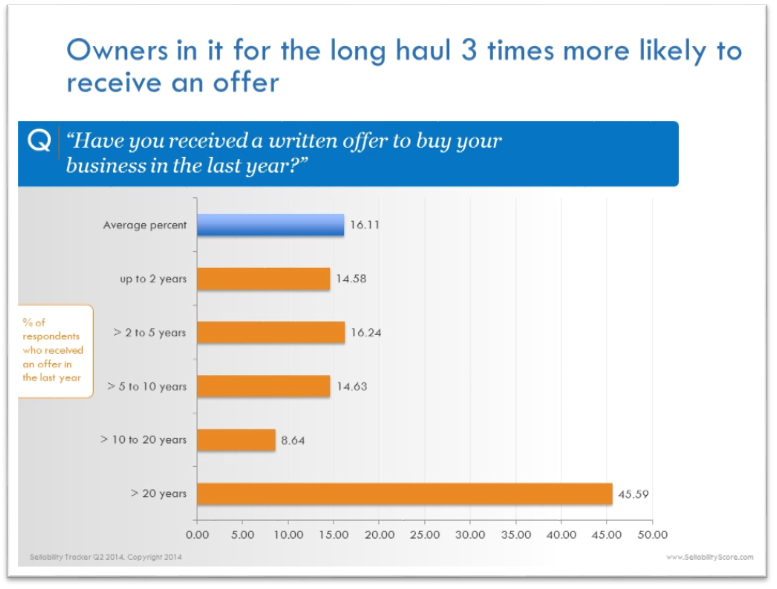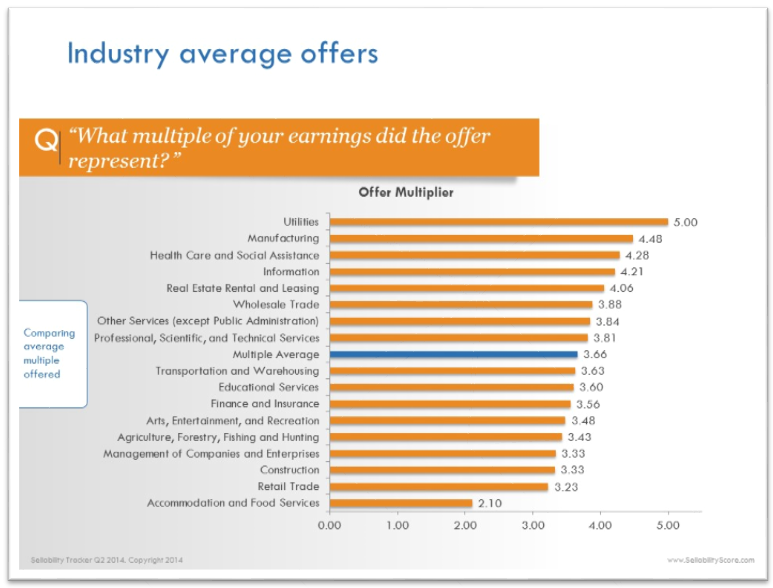
Cross selling new products and services to your existing customers may be a great marketing strategy, but if your goal is to increase the value of your business, the added revenue may do nothing for your company’s value – and may even lower it.
In order to be acquired for a premium, consider committing to a product, service, or a bundle that does one thing well. Your aim should be to make that offering so irresistible, that an acquirer will stop at nothing to get their hands on it. This focus will help you build a team around your product or service and ultimately make your company a whole lot more attractive when it comes time to sell.
However, most companies do the opposite. They take their initial success and water it down by cross-selling additional products, leveraging their relationship with their customers to sell them merely good offerings on the back of their great product or service. The problem with wandering too far a field is that while add on products may increase your revenue, they decrease your attractiveness to a strategic acquirer. Like being asked to buy a cable package of hundreds of channels when all you want is a few, acquirers don’t like buying things they will not use and therefore often walk away from a deal where a great product has been watered down with dozens of less attractive products or service lines.
How Stelligent Lost Its Focus (and found it again)
For example, take a look at Stelligent, a company in the business of helping large enterprises automate their software delivery process. There was a time when big companies used to install their software deep, deep into operations – but the emergence of ‘The Cloud’ changed that. Employees across the globe now get access to the software they use anywhere they have access to a web browser.
Just as you might rent an apartment in a building, software developers pick one of the big cloud service providers like Microsoft Azure, Google Cloud, or Amazon Web Services (AWS) to rent compute, storage, database, and networking resources to run their software systems. Since Azure, Google, and AWS all take a different approach to hosting, an entire industry has been created to help developers configure their software for the cloud service provider they pick.
Paul Duvall, co-founder of Stelligent, is one of the pioneers of this industry called DevOps – which is a set of organizational, culture, process, and tooling practices that accelerate effective feedback between end users to improve the value of the software that’s being delivered. Duvall started Stelligent in 2007 with his then silent partner Rob Daly. The goal was to help developers accelerate how quickly they could bring their software to market.
Stelligent was a typical consulting company, selling the time of the engineers Duvall hired on contract as his business required them.
By 2012, Stelligent had a half dozen contract workers and a few employees hovered around one million in annual revenue, as project demand ebbed and flowed. Duvall felt he was running on a treadmill. Each new project Duvall won required him to build a whole new team. Around this time, Rob Daly – who had enjoyed success starting and growing other companies – encouraged Duvall to read the book Built To Sell, where Duvall especially found tips around specialization to be most valuable.
With a focus on shifting toward even more specialization, Duvall decided to go all in on AWS.
About a year later, in 2014, Daly then joined the team as its 5th employee and would transition to CEO throughout the course of the year becoming very influential in building a team of specialists focused on helping enterprise customers.
As time went by, Stelligent began earning a name for itself as the AWS specialists. As Amazon’s cloud provider service grew in popularity, so did demand for Stelligent’s services. Over the next three years, Stelligent blossomed into a multi-million-dollar business with 30 full-time employees.
By early 2017, Denver-based HOSTING Inc. saw how quickly AWS was growing and concluded that by acquiring Stelligent, they could leapfrog their competition and become a market leader in AWS almost overnight. Later that year, HOSTING acquired Stelligent for about double what a typical consulting company would hope to command for a similar-sized business (when comparing multiples around high-growth companies in the technology sector).
The story of Stelligent is a reminder why you should focus your limited resources on becoming so good in your niche that an acquirer reasons it would take too long – or cost too much – to compete.
Most small businesses with limited cash, can only afford to get that good at solving one problem for their customers. That kind of focus is the opposite of what most sales and marketing pundits preach but it may be the one thing that will make your company irresistible to an acquirer.
Presenting alternative views is something that I routinely do with clients. I can help you tackle these issues and also help you increase the value of your company. Call me, Frank Mancieri at (401) 651-1585 or email him at frank@gtGrowth.com.



















 Professor Roberto has written two books:
Professor Roberto has written two books:  Jay Steinfeld built Blinds.com into a $100 million e-tailer before selling out to Home Depot. Here are five things that made it a spectacular exit.
Jay Steinfeld built Blinds.com into a $100 million e-tailer before selling out to Home Depot. Here are five things that made it a spectacular exit. 
 Chris is Managing Director with Valuation Research Corporation in Norwood, MA. Chris has over 28 years of business valuation experience involving the valuation of over 3,000 businesses and intangible asset valuations. He has started, ran for 15 years, and sold his own business; earned 6 professional certifications; served on several valuation committees; published several articles; led over 100 seminars; provided expert testimony in court; and co-authored a valuation text book – Valuation for M&A: Building Value in Private Companies.
Chris is Managing Director with Valuation Research Corporation in Norwood, MA. Chris has over 28 years of business valuation experience involving the valuation of over 3,000 businesses and intangible asset valuations. He has started, ran for 15 years, and sold his own business; earned 6 professional certifications; served on several valuation committees; published several articles; led over 100 seminars; provided expert testimony in court; and co-authored a valuation text book – Valuation for M&A: Building Value in Private Companies.  David Hirsch a Corporate Attorney with Hinckley Allen & Snyder LLP in Providence. David focuses his practice in the areas of corporate and business law, including commercial and public finance and mergers and acquisitions. He represents companies in general corporate matters and assists with a broad range of business and financing transactions. David also has experience advising financial institutions regarding regulatory compliance.
David Hirsch a Corporate Attorney with Hinckley Allen & Snyder LLP in Providence. David focuses his practice in the areas of corporate and business law, including commercial and public finance and mergers and acquisitions. He represents companies in general corporate matters and assists with a broad range of business and financing transactions. David also has experience advising financial institutions regarding regulatory compliance.  Rob Kerr is Managing Director of CBIZ Tofias in Providence. Rob is a CPA with more than 15 years of experience in tax planning, consulting and compliance services for public companies, privately-held corporations, partnerships and individuals. Rob specializes in the private equity and venture capital industry where he provides assistance with domestic and international tax planning and compliance projects. And extensive experience working with Internal Revenue Code Section 382, assisting clients with ownership changes and associated impact against the certain tax attributes.
Rob Kerr is Managing Director of CBIZ Tofias in Providence. Rob is a CPA with more than 15 years of experience in tax planning, consulting and compliance services for public companies, privately-held corporations, partnerships and individuals. Rob specializes in the private equity and venture capital industry where he provides assistance with domestic and international tax planning and compliance projects. And extensive experience working with Internal Revenue Code Section 382, assisting clients with ownership changes and associated impact against the certain tax attributes.  Mike Tamasi is the President & CEO of AccuRounds in Avon, MA. A second- generation owner since 1985, Mike is responsible for overall strategy and organizational alignment guided by “The Path to Perfection” – providing opportunity for every member of the AccuRounds team. Mike is co-chair of the Massachusetts Advanced Manufacturing Collaborative and Chairman of Business Leaders United.
Mike Tamasi is the President & CEO of AccuRounds in Avon, MA. A second- generation owner since 1985, Mike is responsible for overall strategy and organizational alignment guided by “The Path to Perfection” – providing opportunity for every member of the AccuRounds team. Mike is co-chair of the Massachusetts Advanced Manufacturing Collaborative and Chairman of Business Leaders United. 



 Business valuation goes beyond simple mathematics, but to get some idea of what your business might be worth, consider the three methods below.
Business valuation goes beyond simple mathematics, but to get some idea of what your business might be worth, consider the three methods below.
 For business owners who are thinking about exiting their business in the future, there are many things to consider to assure the business transition happens in a smooth manner and accomplishes your personal and professional / corporate goals. Owners are wise to seek the counsel of advisors in this complex and delicate area. Your choice of experienced advice in this area can mean the difference between success and failure to reach your goals. Not only do you need to know which types of advisors to choose but also when to bring them onto your team. This newsletter provides the top three things to consider when building your exit planning advisory team.
For business owners who are thinking about exiting their business in the future, there are many things to consider to assure the business transition happens in a smooth manner and accomplishes your personal and professional / corporate goals. Owners are wise to seek the counsel of advisors in this complex and delicate area. Your choice of experienced advice in this area can mean the difference between success and failure to reach your goals. Not only do you need to know which types of advisors to choose but also when to bring them onto your team. This newsletter provides the top three things to consider when building your exit planning advisory team. Many owners of privately-held businesses are not pro-active in planning for their exit and the company’s transition. This is true mostly because the ‘exit planning industry’ is nascent and many owners are simply not aware that a service exists to help owners with this complex issue. This newsletter is written to advocate the position that owners should be pro-active and should actively lead their exit plans by involving those that help them manage the business. An owner’s successful exit is an entry point for another owner to take the company to the next level, creating potential opportunities for the leaders in your organization. However, without leading the process, it is not something that you can rely on without proper planning. You might get lucky, but luck is rarely a solid strategy.
Many owners of privately-held businesses are not pro-active in planning for their exit and the company’s transition. This is true mostly because the ‘exit planning industry’ is nascent and many owners are simply not aware that a service exists to help owners with this complex issue. This newsletter is written to advocate the position that owners should be pro-active and should actively lead their exit plans by involving those that help them manage the business. An owner’s successful exit is an entry point for another owner to take the company to the next level, creating potential opportunities for the leaders in your organization. However, without leading the process, it is not something that you can rely on without proper planning. You might get lucky, but luck is rarely a solid strategy. Business owners are risk-takers by nature. Interestingly, however, is the fact that these same owners are often-times not risk averse. What this means is that owners will assume risks in one area of their lives, but not necessarily work to mitigate risks in other areas. The primary issue in not mitigating risks lies in the fact that there are a lot of people in your world who rely on you and the decisions that you make. This newsletter challenges the use of insurance in the singular manner of addressing a loss of life. In fact, insurance products are useful tools throughout the spectrum of advanced planning for a future exit. This newsletter is written with the intention of discussing risk mitigation and broadening owner’s views on how and where insurance can ground and solidify your plans for a future exit, i.e. while you are still alive.
Business owners are risk-takers by nature. Interestingly, however, is the fact that these same owners are often-times not risk averse. What this means is that owners will assume risks in one area of their lives, but not necessarily work to mitigate risks in other areas. The primary issue in not mitigating risks lies in the fact that there are a lot of people in your world who rely on you and the decisions that you make. This newsletter challenges the use of insurance in the singular manner of addressing a loss of life. In fact, insurance products are useful tools throughout the spectrum of advanced planning for a future exit. This newsletter is written with the intention of discussing risk mitigation and broadening owner’s views on how and where insurance can ground and solidify your plans for a future exit, i.e. while you are still alive.












 IMAGE: Getty Images
IMAGE: Getty Images












 We as individuals also have to take care of ourselves, and Arianna Huffington’s new book
We as individuals also have to take care of ourselves, and Arianna Huffington’s new book






